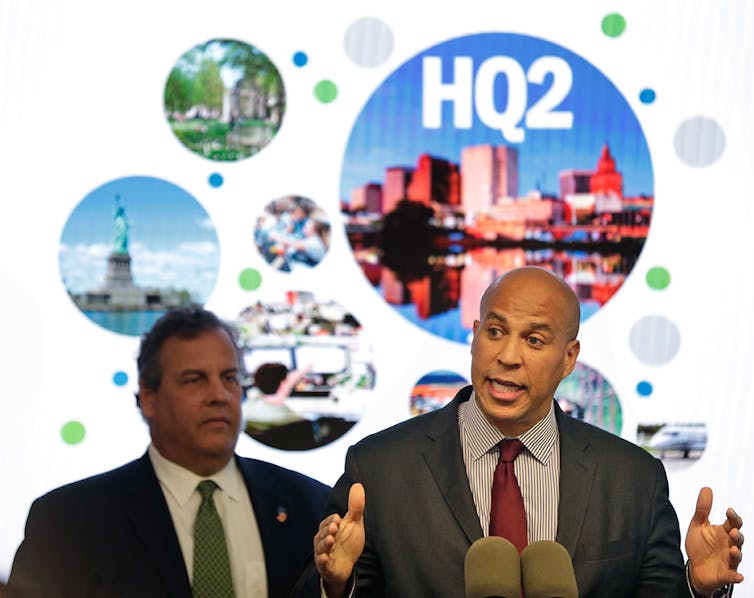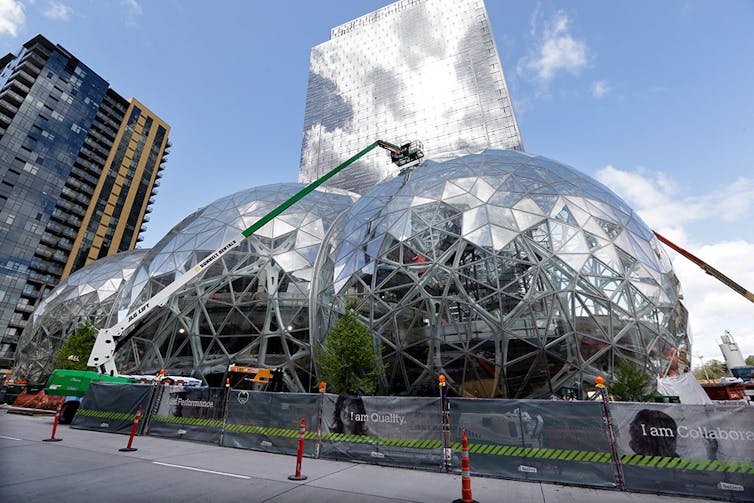White men may be biggest winners when a city snags Amazon’s HQ2
Amazon, like the entire tech sector, has suffered from a lack of diversity in its workforce. This trend is likely to continue when it opens a second headquarters in one of 20 cities.

Amazon may be hosting the biggest – and most economically important – reality show ever as city mayors compete to snag the retailer’s second headquarters. And just like TV, it has a diversity problem.
More than 230 cities made the initial bid, and just recently Amazon whittled that list down to 20 that will go on to the next stage of the competition. Contestants have gone to great lengths to woo the tech giant. Newark, New Jersey, for example, promised over US$7 billion in tax breaks over the next decade.
The winning community, to be announced later this year, will see billions of dollars in new investment and tens of thousands of high-paying jobs as an award. Such a long-term investment naturally would be welcome news for any city, particularly those like Philadelphia and Indianapolis that have seen decades economic divestment.
However, there will almost certainly be drawbacks as well.
As scholars of gender studies and geography, we believe it’s worth taking a closer look in particular at who would fill the jobs Amazon’s new headquarters would create and how it would affect local quality of life.

Workplace diversity
In its search for “HQ2,” Amazon set out a few simple criteria for its city selection: a metropolitan area with more than 1 million people, a stable and business-friendly environment and the ability to attract and retain strong technical talent.
The company said it expects to invest over $5 billion dollars in construction and to generate 50,000 “high-paying jobs,” plus “tens of thousands of additional jobs and tens of billions of dollars in additional investment in the surrounding community.”
A mayor of a city like Atlanta or Chicago, hoping Amazon fills many of those jobs with a diverse selection of its skilled denizens, might be disappointed. That’s because Amazon – and tech companies more broadly – have long had a diversity problem.
The company’s latest diversity data show that 66 percent of its managerial and professional employees are white. While that may seem normal in overwhelmingly white Seattle, almost four-fifths of its employees are based elsewhere.
While Amazon has sought to highlight its diversity, for instance, by noting that 21 percent of its total workforce is African-American, most of them are concentrated in nonprofessional “administrative, labor or helper” roles. In fact, African-Americans held only 3.7 percent of Amazon’s mid-level managerial, professional or technical jobs in 2016, and zero executive or senior management roles.
Given these hiring trends, it is not clear that Amazon will do much for high-skilled minority workers in heavily African-American candidate cities – let alone help their most economically disenfranchised populations.
A gender imbalance
Even though it’s within Amazon’s best interest to invest in hiring more women, the gender and pay equity numbers are bleak.
Sixty-one percent of Amazon’s global workforce are men, as are 75 percent of its managers. Though Amazon touts its gender pay equity (noting that women make 99.7 cents to every dollar that men make for similar positions), female employees are concentrated in lower-tier jobs.
This gender gap is reproduced across the technology industry. According to the U.S. Census Bureau, the share of women in information technology occupations has not only decreased since 1990 by nearly 5 percent, but women continue to cluster in less prestigious “front-end” jobs and not in the highest paying occupations like network architects or software development. A 2017 study by the tech-heavy job board site Hired shows that even when men and women were offered the same position in the same company, women were offered lower salaries 63 percent of the time.
Tech hiring trends are even less favorable for women of color. For example, while Asian women are considered well-represented in the tech workforce overall, a revelatory 2017 report from the nonprofit Ascend Leadership revealed that they were the least likely to become managers and executives. Equally as troubling, the numbers of black women in tech actually declined by 13 percent from 2007 to 2015.

Swallowing a city
Beyond the jobs, however, cities are also hoping for investment and an economic boost. But there are downsides to letting a giant take over your city. Just ask Seattle.
With the intention of supporting local economies, Amazon has established its growing headquarters in downtown Seattle, even encouraging employees to spend money at local shops by limiting on-site dining options.
As a consequence, the city has been swallowed by the company’s offices, which occupy 19 percent of all office space in downtown Seattle, making it not only the city’s largest employer but also its largest user of land, roadways and public space. Traffic and congestion have outstripped the city’s existing infrastructure. Almost 57,000 residents spent at least 90 minutes on their daily commute.
Rents and housing prices have skyrocketed, homelessness is now the third-highest in the country, and the rapid growth of new office buildings and condos is replacing the older, smaller spaces needed for small business and entrepreneurship. Mahmoudi’s research has shown that rapid changes like this can uproot or displace existing residents, reducing both diversity and equity.
To be sure, Seattle has benefited a lot from Amazon’s presence. Our point is that there are lots of costs too.
Chasing smokestacks
Cities have long been known for “smokestack chasing,” or offering lucrative tax incentives and other subsidies to lure companies or factories from elsewhere. These policies have often don’t work.
You might call today’s race to get Amazon’s second headquarters a modern form of that phenomenon as municipalities compete in a zero-sum game for tech company outposts.
Yet all of the presumed economic benefits are problematically predicated on the companies’ continued growth, which is never a sure thing. The negative impacts, however, are much more certain.
The authors do not work for, consult, own shares in or receive funding from any company or organization that would benefit from this article, and have disclosed no relevant affiliations beyond their academic appointment.
Read These Next
As US hunger rises, Trump administration’s ‘efficiency’ goals cause massive food waste
Despite the administration’s claim of streamlining the government to make its operations more efficient,…
Absence of evidence is not evidence of absence – and that affects what scientific journals choose to
Researchers design studies that might disprove what’s called their null hypothesis – the opposite…
Pentagon investigation of Sen. Mark Kelly revives Cold War persecution of Americans with supposedly
President Donald Trump and his supporters cast their domestic opponents as disloyal, traitorous or worse,…





